ResearchEducation & Skills, Black Boys & Men
Educational achievement and progression by gender in Washington: 6 key takeaways

Summary
Using data for hundreds of thousands of high school students in Washington public schools across several cohorts, we analyze student outcomes for key metrics such as GPA, on-time graduation, absenteeism, test scores, and advanced course taking across gender and race.
With the ability to link high school metrics to performance on 3rd grade test scores, we were able to connect high school outcomes to past performance. We observe several key findings regarding gender and race gaps in Washington public schools.
The results presented here are currently descriptive and tackle neither causal patterns nor policy prescriptions.
Key takeaways
- There are large gender gaps in high school GPAs:
- 51% of girls graduate with a GPA above 3.0 compared to 36% of boys
- Girls are 1.9 times as likely to be in the top 5% of graduating GPAs, while boys are 1.6 times as likely to be in the bottom 5%.
- Boys are less likely to graduate on time and take advanced high school English coursework. However, boys and girls score similarly on math tests and take advanced math courses at approximately the same rate.
- These gaps are generally not explained by earlier performance in school: for example, for boys and girls in both the top 10% and bottom 10% of the 3rd grade test score distribution, girls have significantly higher GPAs in high school.
- These gaps persist across racial groups and are highest for Black girls and boys.
We draw on annual data maintained by the Office of the Superintendent of Public Instruction in Washington State (OSPI). We leverage the Core Student Record System for data from 2004-05 to 2008-2009, and the Comprehensive Education Data and Research System (CEDARS) from 2009-2010 to present. Note that while we use 3rd grade as the baseline year throughout our analysis, results are qualitatively similar if we focus on a sample of students in any given year between 3rd grade and year of outcome. Sample sizes vary by outcome, and not all outcomes are available across years. The overall sample is 60% white, 19% Hispanic, 8% Asian, 6% Black and 7% some other race.
(1) Girls have higher GPAs, ELA test scores, take more advanced coursework, and are more likely to graduate on time.
One of the most notable findings is a gender gap that exists between girls and boys in high school GPA. Among the cohorts studied, 51% of graduating girls had a high school GPA above 3.0 compared to only 36% of boys.
This gap is especially prominent in the tails of the GPA distribution: girls are 1.9 times as likely to be in the top 5% of graduating GPAs, and boys are 1.6 times as likely to be in the bottom 5%.
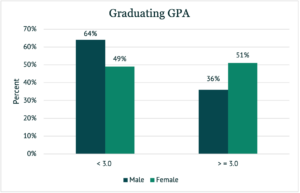
Figure 1. Share of students by gender with graduating GPAs above and below 3.0.
Female students also make up 63% of students with top English Language Arts (ELA) test scores (95th percentile and above), and are also more likely to take advanced coursework in high school. While almost equal shares of girls and boys take advanced math courses, girls are 6.5 percentage points more likely to take advanced ELA courses.

Figure 2. Share of students that took any advanced coursework in high school, by subject and gender.
Boys in Washington are also slightly less likely to graduate on time; 85% of girls and 79% of boys graduate on time from high school, a gap that persists across racial groups, as seen in Figure 3.
(2) These gender gaps exist in all racial groups, but tend to be smaller for Asian students and larger for Black students.
The gender disparities we found in GPA, graduation, coursework, and test scores exist across all racial groups, but magnitudes of the gap vary somewhat by group. These differences are most pronounced in on-time high school graduation rates, with a only 4.4 percentage point difference between Asian males and females, and a 10.3 percentage point difference for Black males and females.
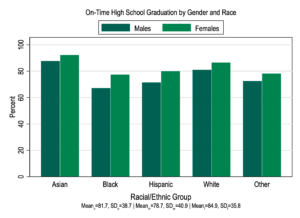
Figure 3. On-time high school graduation by gender and race.
This pattern holds for GPA as well. As seen in Figure 4, Asian students have a mean GPA gender gap of 0.27, the smallest, and Black students have the largest mean GPA gap, 0.33. Advanced ELA coursework is an exception to this trend, where Hispanics have the smallest gender gap. Notably, Black students, regardless of gender, are more likely to take advanced ELA courses than any other racial/ethnic group except for Asian students. See slide 15 in the slide deck linked above for a chart of advanced ELA course taking by race.
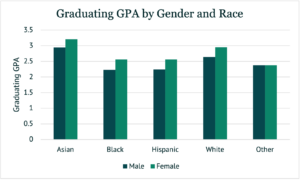
Figure 4. Graduating GPA by gender and race.
(3) Gender disparities exist regardless of earlier academic performance.
One potential explanation for these gaps is that they are just a continuation of an established trend or influenced by a small number of high achieving girls. We thus use 3rd grade test scores to help control for earlier academic achievement and examine results along the distribution of prior test scores.
The analysis reveals that girls outperform boys on these metrics regardless of prior academic achievement. Boys and girls who were in the top 10% of the 3rd grade test score distribution have a gender gap in GPA (shown below in Figure 5) similar to the one among students in the bottom 10% of the test score distribution. For advanced ELA course taking (available on slide 11 in the linked slide deck), the gap between boys and girls is narrowest at the bottom of the distribution and wider for students above the first decile of the distribution. This consistent advantage for girls, irrespective of early academic standing, indicates a broader, more complex dynamic at play in the gender disparities observed in educational outcomes.
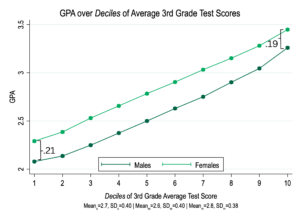
Figure 5. High school GPA as predicted by 3rd grade test scores. For example, boys who have scores in this first decile will on average go on to have a GPA that is .21 lower than girls who also scored at the first decile.
(4) Gaps in ELA test scores widen in middle school and shrink in high school.
To understand how gaps in ELA scores change over time by gender, we used regression analysis, including an interaction effect between gender and 3rd grade test scores. By 6th grade, the gap that was already present in third grade ELA scores has widened across the performance distribution, and the gap only gets larger into 8th grade, with boys at the bottom quintile and the top quintile of third grade scores falling particularly behind girls in the same third grade quintile as them. But then by 10th grade, boys catch up somewhat, reducing the gap by a significant margin.
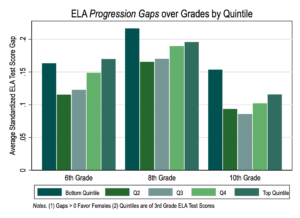
Figure 6. Standardized gaps in ELA test scores over time. Values above 0 indicate gaps that favor females. Quintiles are of 3rd grade ELA test scores.
(5) Gaps in math scores are small, especially in third grade. By 10th grade there is a higher share of boys in the top – and the bottom.
In third grade, the distribution of male and female math test scores look almost equivalent. In the 95th percentile and above of math scores, we see 5% of boys and 4.8% of girls, and in the bottom 5th percentile we see 5.4% of boys and 4.6% of girls. By 10th grade, the difference becomes more stark, as boys become overrepresented at both the top and bottom ends of math test scores. Boys represent 5.8% of the 95th percentile and above (compared to 4.1% of girls), and 5.9% of the 5th percentile and below (compared to 4.3% of girls). The girls’ scores shift more to the middle while the boys make up most of the tails – the high and low extremes.
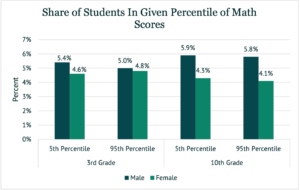
Figure 7. Percent of students in 5th and 95th percentiles of math test scores in 3rd and 10th grade.
(6) Girls have more absences overall, but boys have more unexcused absences
In addition to academic performance metrics, we examined absenteeism. Pooling across years gave us a sample size of over 10 million students across 12 grades, and precise insights into attendance levels. As shown below, in elementary school, absences are very similar across genders. From 8th grade onward, females had more total absences on average, but when we look at unexcused absences, males had more – and the gaps increased in later grades.
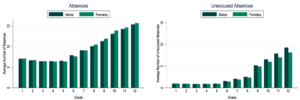
Figure 8. Absenteeism: Average number of absences by grade, gender and type of absence. Average total absences a year is 9.6 (9.7 for females, 9.6 for males), and average unexcused absences is 3.2 (3.0 for females, 3.3 for males).
Summary
Looking at outcomes for hundreds of thousands of students in Washington State over several cohorts, we found several gender gaps in important metrics. Boys are less likely to graduate on time and take advanced coursework while being more likely to have unexcused absences, lower GPAs and lower ELA test scores. These gaps are pervasive – they are found across all racial groups and levels of previous academic achievement.
For the full analysis, see the complete slide deck.
Acknowledgement to Will Secker for helping compile the findings as seen in this post.
Subscribe to our newsletter
Get the latest developments on the trends and issues facing boys and men.
Related Research

Education & Skills, Black Boys & Men
Men in higher education: A national data tool
Explore our new tool to track men's higher ed trends—enrollment, graduation, salary—by school and state.

Education & Skills, Black Boys & Men
What teens want to be: Gender differences in careers and majors
Explore how teen career goals and college major choices differ by gender, revealing early divides in aspirations and educational paths.

Education & Skills, Black Boys & Men
A generation of lost men? The reality of NEET data
Explore NEET trends and the rise of “lost men”—youth not in education, employment, or training—shaped by gender, race, disability, and more.